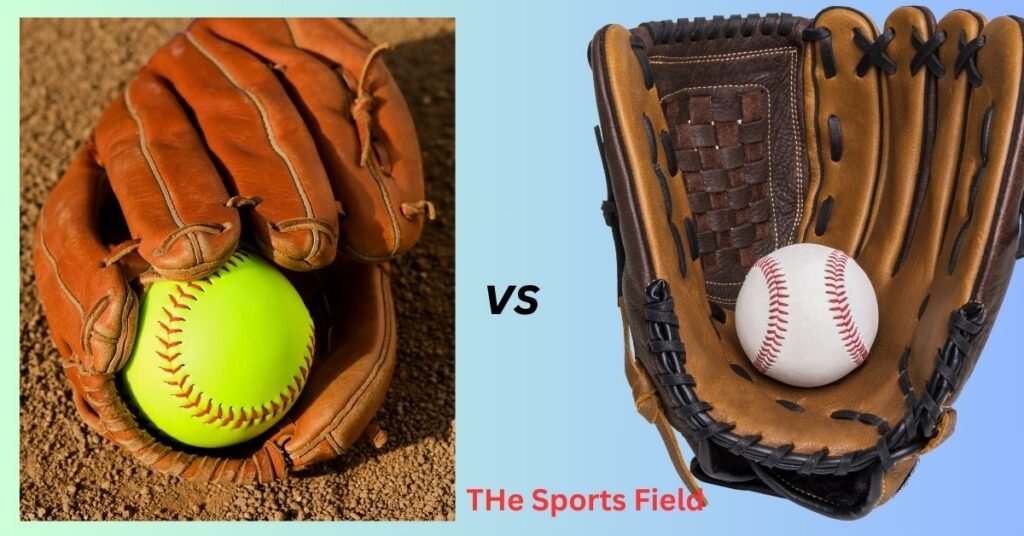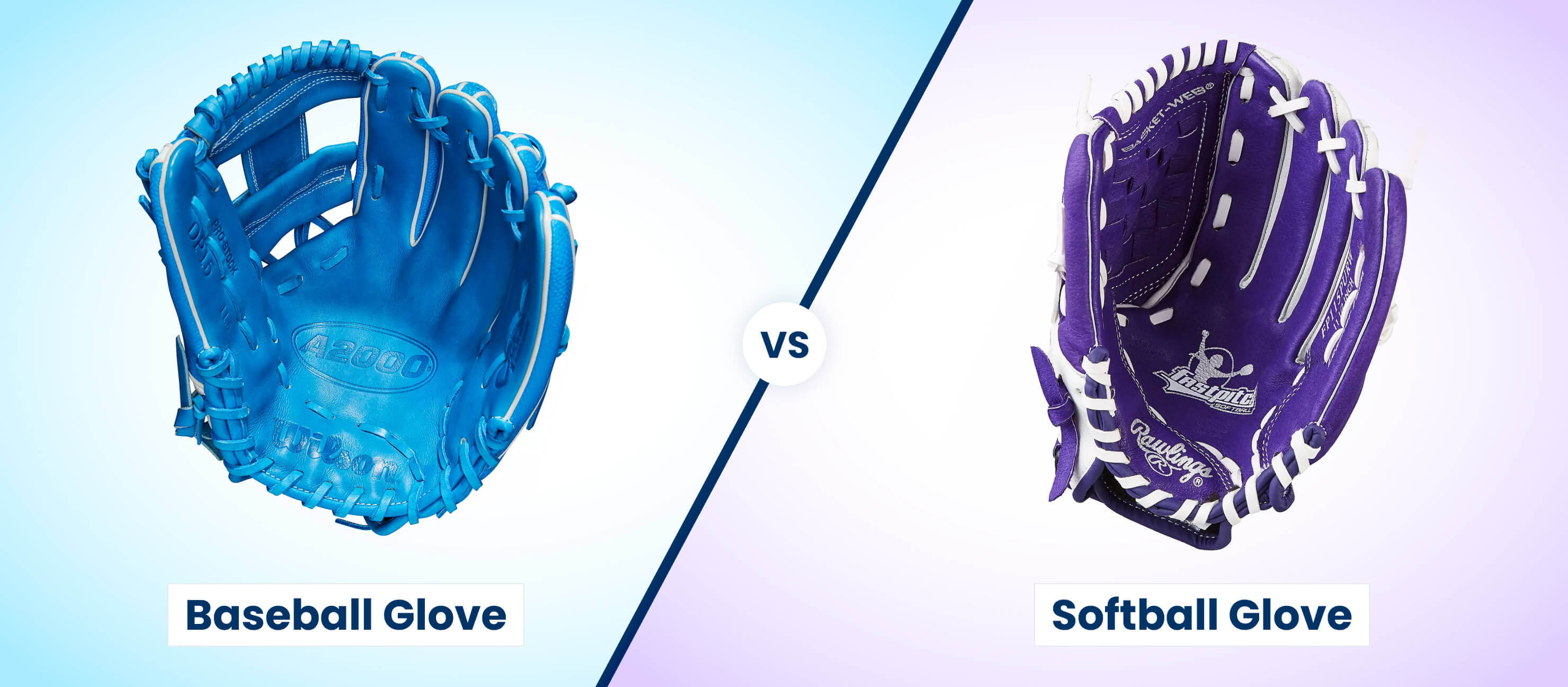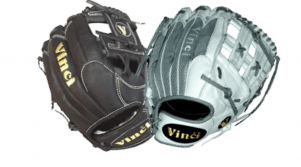Yes, softball gloves differ from baseball gloves. Softball gloves are larger to accommodate the bigger ball size.
Softball and baseball may seem similar, but their equipment has key differences. One significant difference lies in the gloves used by players. Softball gloves have a larger pocket and a deeper webbing to catch the larger, softer ball. Baseball gloves are smaller with a tighter fit, designed for the smaller, harder baseball.
Choosing the right glove enhances performance and comfort in the respective sports. Understanding these differences ensures players select the correct gear, improving their game experience. Both sports require unique equipment tailored to their specific gameplay needs.

Glove Design
Understanding the design differences between softball and baseball gloves is crucial for optimal performance. Each sport has unique requirements that influence glove design. Let’s explore these differences, focusing on shape size and pocket depth.
Shape And Size
Softball gloves are generally larger than baseball gloves. This size difference helps to catch the bigger softball. Here are some key points:
- Softball gloves range from 12 to 14 inches.
- Baseball gloves range from 9 to 13 inches.
Another difference lies in the shape of the glove. Softball gloves often have a more rounded shape. Baseball gloves usually have a more tapered shape.
| Type of Glove | Typical Size Range | Shape |
|---|---|---|
| Softball Glove | 12-14 inches | Rounded |
| Baseball Glove | 9-13 inches | Tapered |
Pocket Depth
The pocket depth is another significant difference. Softball gloves have deeper pockets. This helps in catching and securing the larger softball. Key points include:
- Softball gloves have deeper pockets for better ball retention.
- Baseball gloves have shallower pockets for quicker ball transfers.
This difference in pocket depth impacts how each glove performs. A deeper pocket in a softball glove helps secure the ball better. A shallower pocket in a baseball glove allows for quicker throws.
Material Used
When choosing between softball and baseball gloves, the material used is crucial. The material affects the glove’s durability, flexibility, and performance. Various materials cater to different needs and preferences. Understanding these materials helps players make informed decisions.
Leather Types
Leather gloves are highly popular for both softball and baseball. They offer excellent durability and comfort. There are different types of leather used in making these gloves:
- Full-grain leather: Known for its durability and strength. It requires a break-in period but lasts longer.
- Top-grain leather: Slightly less durable than full-grain. It is easier to break in and more flexible.
- Premium steerhide: Offers a balance between durability and flexibility. Commonly used by professional players.
- Kip leather: Lightweight and very durable. It provides a comfortable feel and breaks in quickly.
Synthetic Options
Synthetic gloves are an alternative to leather. They are typically less expensive and require no break-in period. Here are some common synthetic materials used:
- Vinyl: Often used for youth gloves. It is lightweight but less durable than other materials.
- PU (Polyurethane): More durable than vinyl. It offers a good balance of flexibility and strength.
- Microfiber: Mimics the feel of leather. It is durable, flexible, and easy to maintain.
- Nylon: Lightweight and resistant to wear. It is often used in combination with other materials.
In summary, softball and baseball gloves come in various materials. Leather options provide durability and a traditional feel. Synthetic gloves offer affordability and ease of use. Knowing the differences helps players choose the right glove for their needs.
Webbing Styles
Softball gloves and baseball gloves differ in many ways. One key difference is their webbing styles. Webbing styles affect how players catch and control the ball. There are two main types: closed webbing and open webbing.
Closed Webbing
Closed webbing is a solid piece of leather. It offers more support and stability. This style is common for pitchers. It hides the ball from the batter. Softball gloves often use closed webbing because the ball is larger.
Advantages of closed webbing:
- Better for hiding the ball
- Provides more support
- Durable and strong
Open Webbing
Open webbing features spaces between the leather strips. This style is lighter and offers more flexibility. Outfielders and infielders prefer open webbing. It helps them see through the glove and catch fly balls. Baseball gloves often use open webbing for better visibility.
Advantages of open webbing:
- Lightweight and flexible
- Better visibility
- Good for catching fly balls
Choosing the right webbing is crucial. It depends on your position and playing style. Whether you play softball or baseball, understanding webbing styles helps you perform better on the field.
Finger Stalls
Finger stalls play a vital role in both softball and baseball gloves. They ensure a comfortable fit and enhance control. Understanding their differences can help players choose the right glove.
Finger Placement
Finger placement in softball gloves differs from that in baseball gloves. Softball gloves have wider finger stalls. This accommodates the larger softball. Baseball gloves have narrower finger stalls. They fit the fingers more snugly for better ball control.
Size Variations
Softball gloves often have longer finger stalls. This allows players to catch the larger ball easily. Baseball gloves have shorter finger stalls. They offer more precision and control needed for the smaller ball.
Padding And Protection
Softball and baseball gloves offer unique padding and protection. This ensures players stay safe and perform well. Let’s dive into the differences between palm padding and wrist support.
Palm Padding
Softball gloves have extra padding in the palm. This helps absorb the impact of larger, softer balls. The padding is crucial because softball games often involve more intense catching. Baseball gloves, on the other hand, feature thinner padding. This allows for better ball control and quicker transfers.
| Glove Type | Palm Padding |
|---|---|
| Softball Gloves | Thicker Padding |
| Baseball Gloves | Thinner Padding |
Wrist Support
Wrist support is another key difference. Softball gloves often include adjustable wrist straps. This feature provides extra stability during play. Baseball gloves usually have a more flexible design. This allows for a full range of motion.
- Softball gloves: Adjustable wrist straps
- Baseball gloves: Flexible wrist design
Both sports demand different levels of wrist support. This ensures players can perform their best.

Credit: www.academy.com
Position-specific Gloves
Softball and baseball gloves are crafted for different positions on the field. Each position demands unique features for optimal performance. These specialized gloves help players excel in their roles.
Infield Gloves
Infield gloves are designed for quick plays and fast throws. They have a smaller pocket, allowing for rapid ball transfer. Baseball infield gloves typically range from 11 to 12 inches. Softball infield gloves are slightly larger, usually between 11.5 to 12.5 inches.
Key features of infield gloves include:
- Shallow pockets for quick ball retrieval
- Tight, snug fit for better control
- Durable leather for frequent use
These gloves are perfect for shortstop, second base, and third base positions. They offer the agility and control required for these roles.
Outfield Gloves
Outfield gloves are larger and have deeper pockets. This design helps catch fly balls with ease. Baseball outfield gloves range from 12 to 13 inches. Softball outfield gloves are even larger, typically 12.5 to 14 inches.
Important features of outfield gloves include:
- Deep pockets for secure ball-catching
- Longer fingers for extended reach
- Sturdier webbing for high-impact catches
These gloves are ideal for left, center, and proper fields. They provide the reach and security needed for these outfield roles.
Breaking In Process
The breaking-in process for softball and baseball gloves is crucial. This step ensures the glove fits comfortably and functions optimally. Both gloves require specific techniques and products to soften the leather and shape the glove.
Oil And Conditioners
Using oil and conditioners is essential in breaking a glove. These products soften the leather, making it more flexible. Choose a conditioner specifically made for gloves.
- Apply a small amount of oil.
- Rub the oil into the leather.
- Let the glove sit overnight.
Do this process a few times to see a difference? Avoid over-oiling as it can damage the glove.
Shaping Techniques
Shaping your glove is as important as conditioning it. Follow these shaping techniques to get the best results:
- From the pocket: Use a softball or baseball to shape the glove’s pocket. Place the ball in the glove and tie it closed with a rubber band.
- Pound the glove: Use a mallet or your fist to pound the pocket and fingers. This softens the leather and creates a deeper pocket.
- Play catch: Playing catch is a natural way to break in a glove. The repeated impact of catching the ball helps to shape and soften the glove.
Repeating these steps will ensure your glove is game-ready.

Credit: vincipro.com
Price Differences
Understanding the price differences between softball and baseball gloves can help you make an informed decision. While both types of gloves serve similar purposes, their costs can vary significantly.
Cost Factors
Several factors influence the cost of softball and baseball gloves. These factors include:
- Materials used
- Brand reputation
- Design specifications
Premium materials like leather increase the price. Popular brands also tend to charge more. Specialized design features for different positions can add to the cost.
Investment Value
When considering the investment value, think about durability and performance. Higher-priced gloves often last longer and provide better performance.
Durable gloves may cost more upfront but save money over time. A high-quality glove can enhance your game, making it a worthwhile investment.
| Type | Average Price | Premium Price |
|---|---|---|
| Softball Gloves | $50 – $150 | $200+ |
| Baseball Gloves | $60 – $200 | $250+ |
Both softball and baseball gloves have a broad price range. Making an informed choice ensures you get the best value for your money.

Credit: www.justballgloves.com
Frequently Asked Questions
Can I Play Baseball With A Softball Glove?
Yes, you can play baseball with a softball glove. Softball gloves are typically larger, which may affect performance.
Is There A Difference Between Baseball Gloves And Softball Gloves?
Yes, baseball gloves and softball gloves differ. Softball gloves are generally larger to accommodate the larger ball. Baseball gloves have a smaller pocket for better ball control.
What Is An Illegal Glove In Softball?
An illegal glove in softball exceeds size limits or has foreign substances. It gives an unfair advantage, violating rules.
Conclusion
Choosing the right glove is crucial for optimal performance in both softball and baseball. While they may look similar, differences in size, pocket depth, and webbing make each unique. Understanding these variations helps players select the right gear. Equip yourself properly and elevate your game to new heights.
